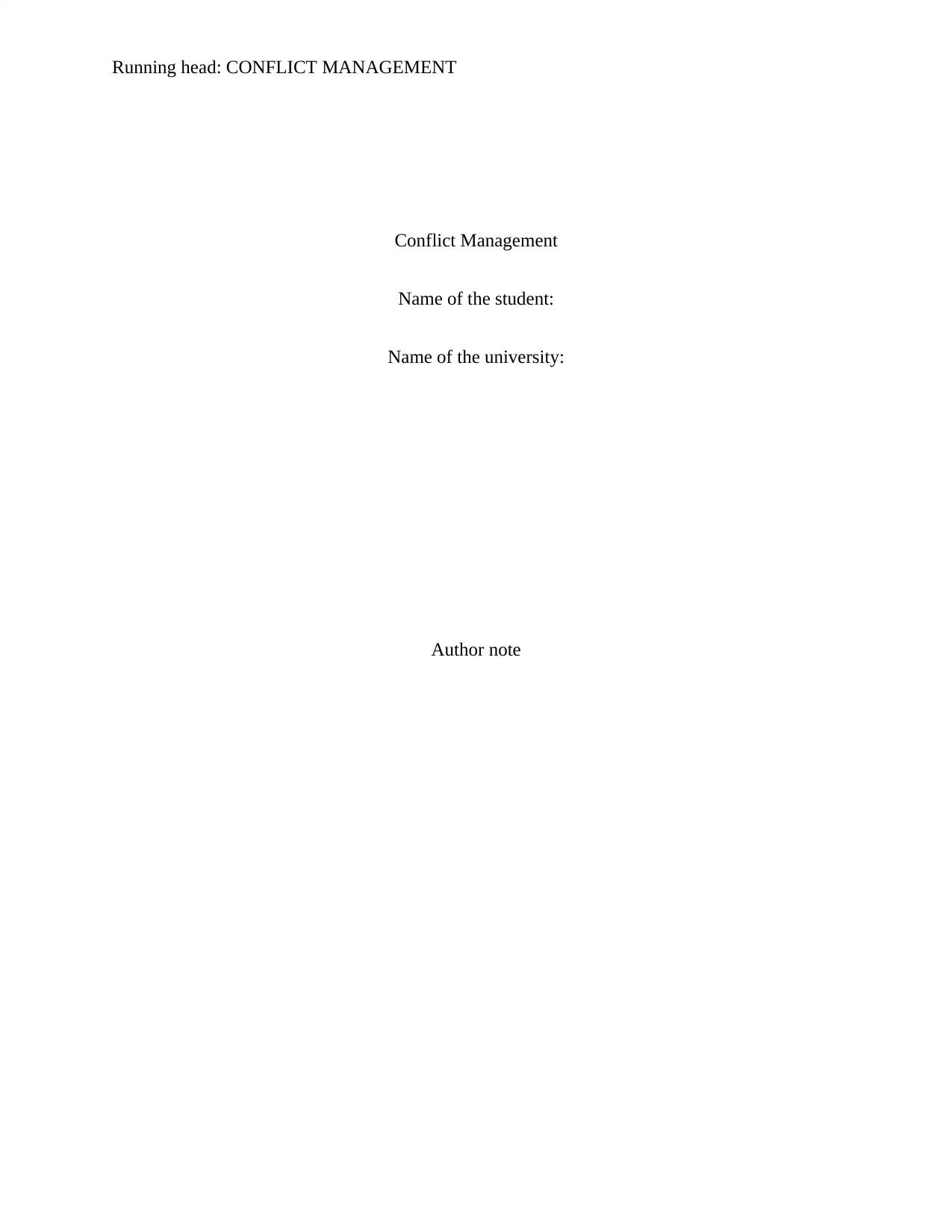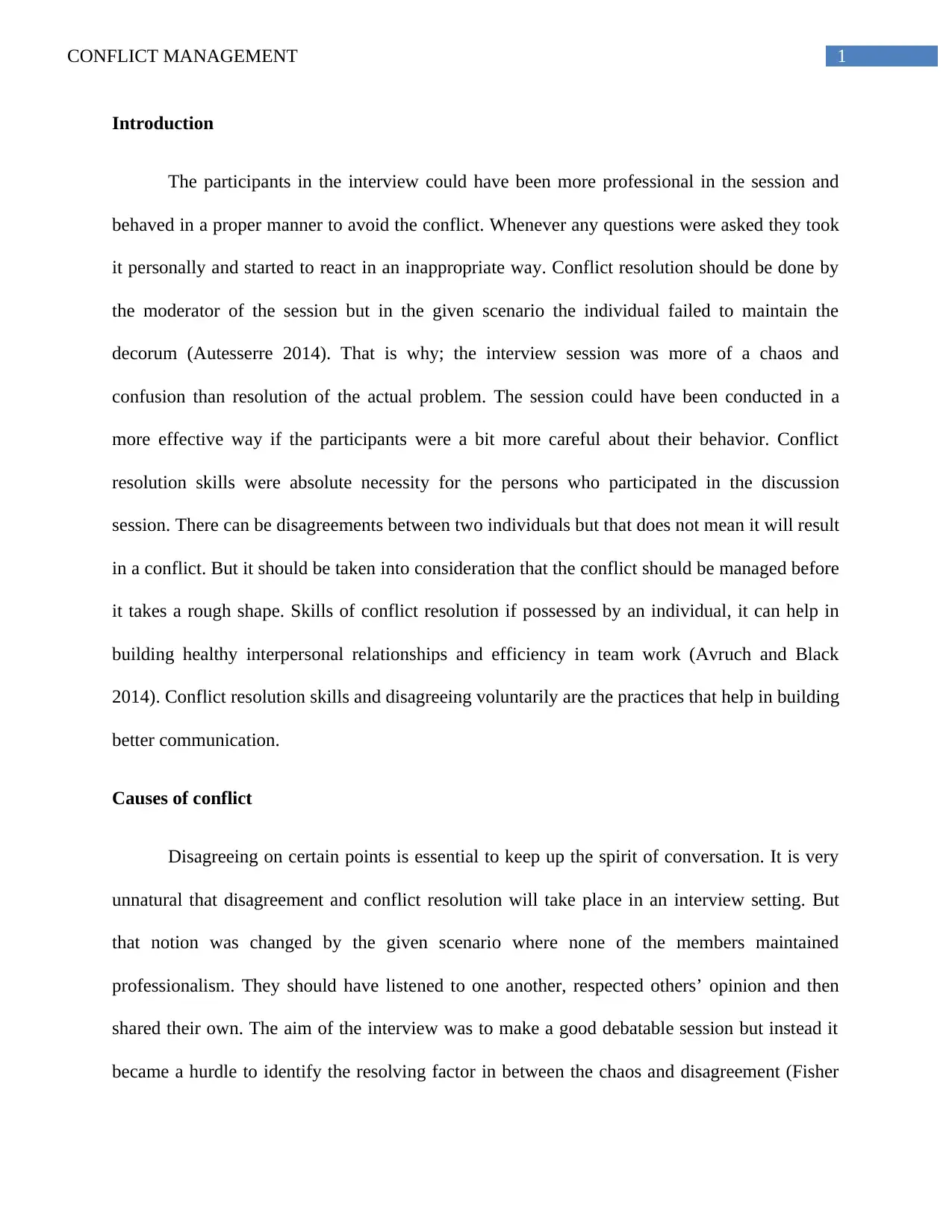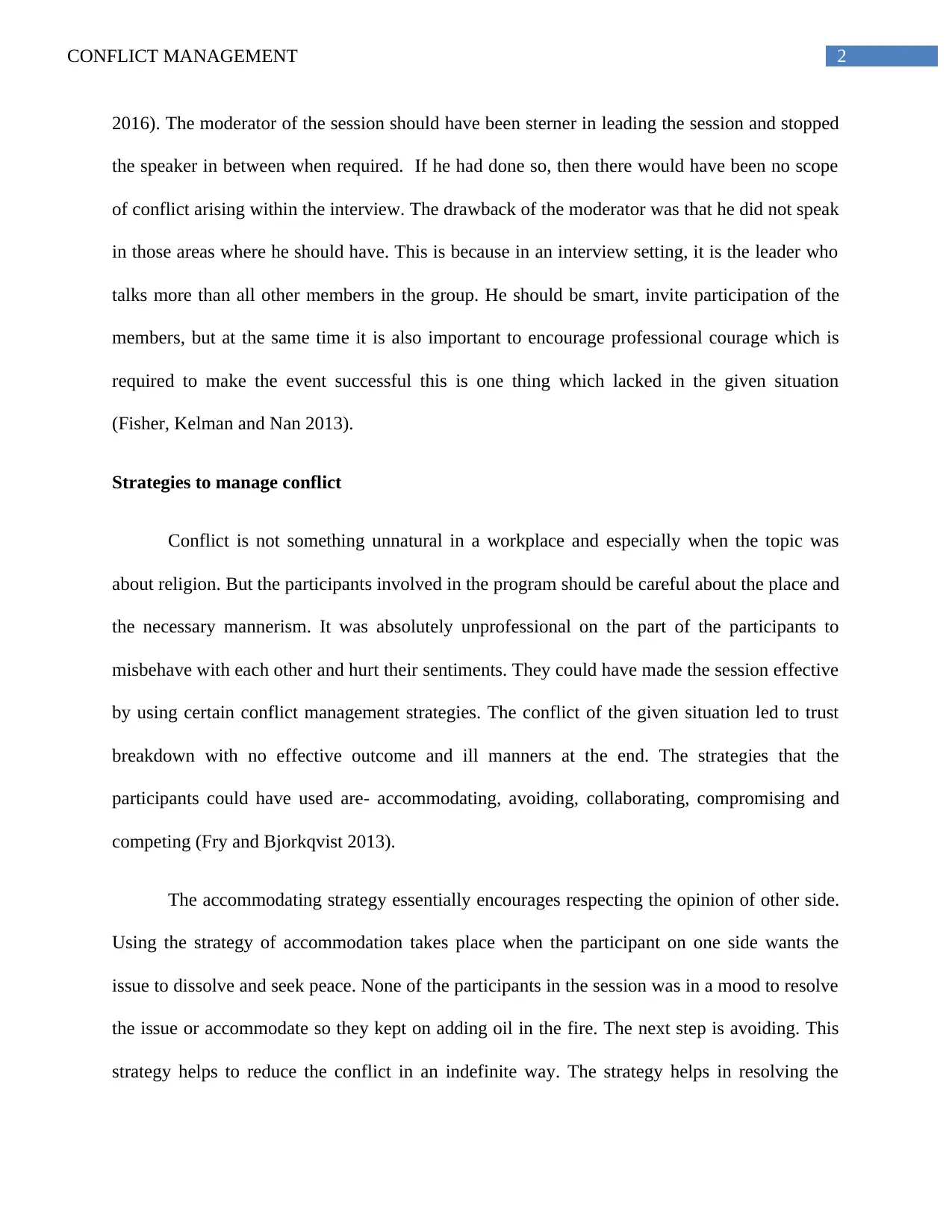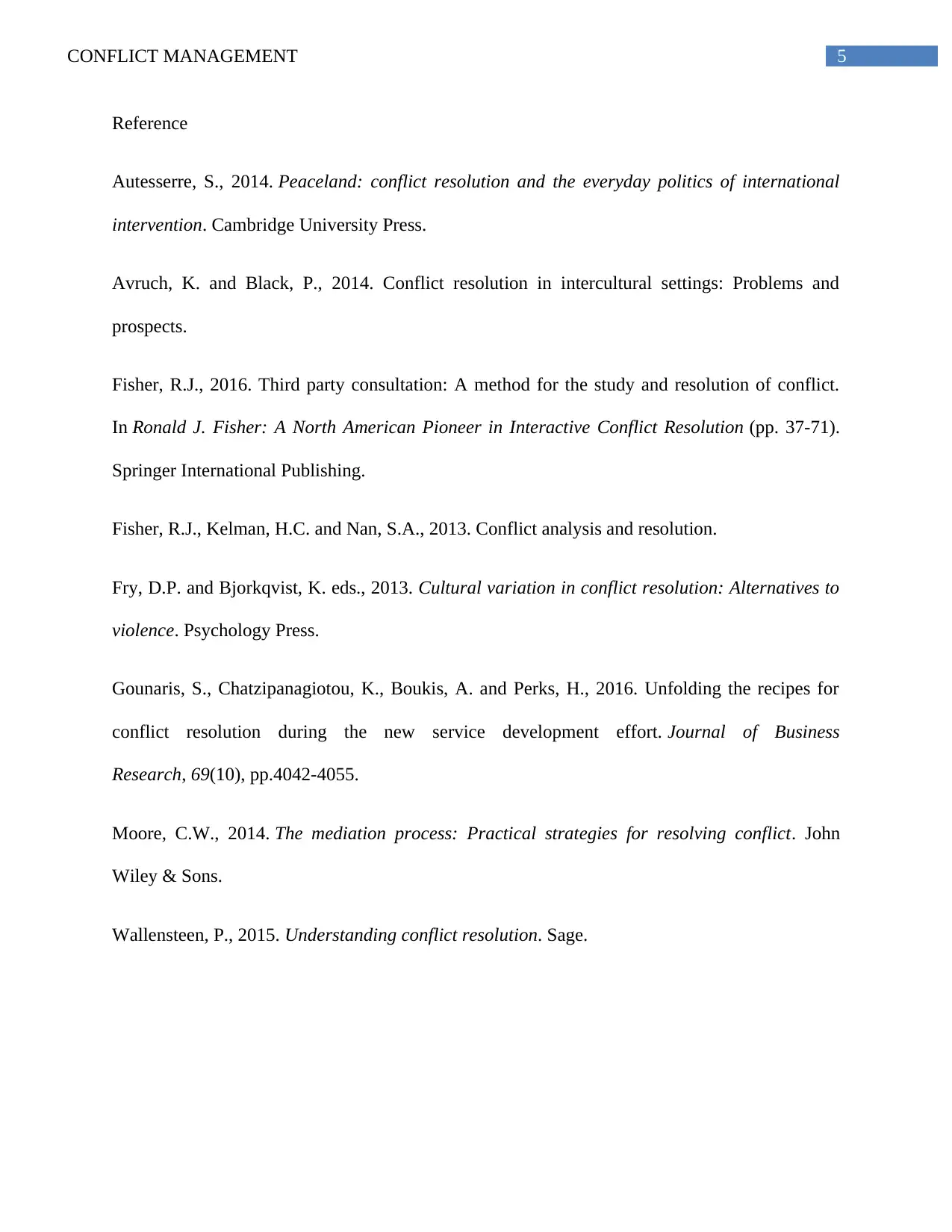Conflict Management Report: Analyzing Causes, Strategies, and Outcomes
VerifiedAdded on 2020/03/28
|6
|1322
|55
Report
AI Summary
This report delves into the intricacies of conflict management, analyzing a case study where an interview session devolved into chaos due to a lack of professionalism and effective conflict resolution. The report highlights the importance of professional conduct and the moderator's role in maintaining decorum. It explores the causes of conflict, emphasizing the need for respectful communication and the ability to manage disagreements constructively. The core of the report focuses on various conflict management strategies, including accommodating, avoiding, collaborating, compromising, and competing, evaluating their suitability for the given scenario. The analysis underscores the significance of choosing the right strategy based on the context and the participants' willingness to find a resolution. The report concludes by emphasizing the necessity of conflict resolution skills for building healthy interpersonal relationships and fostering efficiency in teamwork within a professional environment.

Running head: CONFLICT MANAGEMENT
Conflict Management
Name of the student:
Name of the university:
Author note
Conflict Management
Name of the student:
Name of the university:
Author note
Paraphrase This Document
Need a fresh take? Get an instant paraphrase of this document with our AI Paraphraser

1CONFLICT MANAGEMENT
Introduction
The participants in the interview could have been more professional in the session and
behaved in a proper manner to avoid the conflict. Whenever any questions were asked they took
it personally and started to react in an inappropriate way. Conflict resolution should be done by
the moderator of the session but in the given scenario the individual failed to maintain the
decorum (Autesserre 2014). That is why; the interview session was more of a chaos and
confusion than resolution of the actual problem. The session could have been conducted in a
more effective way if the participants were a bit more careful about their behavior. Conflict
resolution skills were absolute necessity for the persons who participated in the discussion
session. There can be disagreements between two individuals but that does not mean it will result
in a conflict. But it should be taken into consideration that the conflict should be managed before
it takes a rough shape. Skills of conflict resolution if possessed by an individual, it can help in
building healthy interpersonal relationships and efficiency in team work (Avruch and Black
2014). Conflict resolution skills and disagreeing voluntarily are the practices that help in building
better communication.
Causes of conflict
Disagreeing on certain points is essential to keep up the spirit of conversation. It is very
unnatural that disagreement and conflict resolution will take place in an interview setting. But
that notion was changed by the given scenario where none of the members maintained
professionalism. They should have listened to one another, respected others’ opinion and then
shared their own. The aim of the interview was to make a good debatable session but instead it
became a hurdle to identify the resolving factor in between the chaos and disagreement (Fisher
Introduction
The participants in the interview could have been more professional in the session and
behaved in a proper manner to avoid the conflict. Whenever any questions were asked they took
it personally and started to react in an inappropriate way. Conflict resolution should be done by
the moderator of the session but in the given scenario the individual failed to maintain the
decorum (Autesserre 2014). That is why; the interview session was more of a chaos and
confusion than resolution of the actual problem. The session could have been conducted in a
more effective way if the participants were a bit more careful about their behavior. Conflict
resolution skills were absolute necessity for the persons who participated in the discussion
session. There can be disagreements between two individuals but that does not mean it will result
in a conflict. But it should be taken into consideration that the conflict should be managed before
it takes a rough shape. Skills of conflict resolution if possessed by an individual, it can help in
building healthy interpersonal relationships and efficiency in team work (Avruch and Black
2014). Conflict resolution skills and disagreeing voluntarily are the practices that help in building
better communication.
Causes of conflict
Disagreeing on certain points is essential to keep up the spirit of conversation. It is very
unnatural that disagreement and conflict resolution will take place in an interview setting. But
that notion was changed by the given scenario where none of the members maintained
professionalism. They should have listened to one another, respected others’ opinion and then
shared their own. The aim of the interview was to make a good debatable session but instead it
became a hurdle to identify the resolving factor in between the chaos and disagreement (Fisher

2CONFLICT MANAGEMENT
2016). The moderator of the session should have been sterner in leading the session and stopped
the speaker in between when required. If he had done so, then there would have been no scope
of conflict arising within the interview. The drawback of the moderator was that he did not speak
in those areas where he should have. This is because in an interview setting, it is the leader who
talks more than all other members in the group. He should be smart, invite participation of the
members, but at the same time it is also important to encourage professional courage which is
required to make the event successful this is one thing which lacked in the given situation
(Fisher, Kelman and Nan 2013).
Strategies to manage conflict
Conflict is not something unnatural in a workplace and especially when the topic was
about religion. But the participants involved in the program should be careful about the place and
the necessary mannerism. It was absolutely unprofessional on the part of the participants to
misbehave with each other and hurt their sentiments. They could have made the session effective
by using certain conflict management strategies. The conflict of the given situation led to trust
breakdown with no effective outcome and ill manners at the end. The strategies that the
participants could have used are- accommodating, avoiding, collaborating, compromising and
competing (Fry and Bjorkqvist 2013).
The accommodating strategy essentially encourages respecting the opinion of other side.
Using the strategy of accommodation takes place when the participant on one side wants the
issue to dissolve and seek peace. None of the participants in the session was in a mood to resolve
the issue or accommodate so they kept on adding oil in the fire. The next step is avoiding. This
strategy helps to reduce the conflict in an indefinite way. The strategy helps in resolving the
2016). The moderator of the session should have been sterner in leading the session and stopped
the speaker in between when required. If he had done so, then there would have been no scope
of conflict arising within the interview. The drawback of the moderator was that he did not speak
in those areas where he should have. This is because in an interview setting, it is the leader who
talks more than all other members in the group. He should be smart, invite participation of the
members, but at the same time it is also important to encourage professional courage which is
required to make the event successful this is one thing which lacked in the given situation
(Fisher, Kelman and Nan 2013).
Strategies to manage conflict
Conflict is not something unnatural in a workplace and especially when the topic was
about religion. But the participants involved in the program should be careful about the place and
the necessary mannerism. It was absolutely unprofessional on the part of the participants to
misbehave with each other and hurt their sentiments. They could have made the session effective
by using certain conflict management strategies. The conflict of the given situation led to trust
breakdown with no effective outcome and ill manners at the end. The strategies that the
participants could have used are- accommodating, avoiding, collaborating, compromising and
competing (Fry and Bjorkqvist 2013).
The accommodating strategy essentially encourages respecting the opinion of other side.
Using the strategy of accommodation takes place when the participant on one side wants the
issue to dissolve and seek peace. None of the participants in the session was in a mood to resolve
the issue or accommodate so they kept on adding oil in the fire. The next step is avoiding. This
strategy helps to reduce the conflict in an indefinite way. The strategy helps in resolving the
⊘ This is a preview!⊘
Do you want full access?
Subscribe today to unlock all pages.

Trusted by 1+ million students worldwide

3CONFLICT MANAGEMENT
conflict without confrontation by delaying or avoiding the situation. But this seemed to be
impossible in the given case because the situation itself promoted the rise of the conflict
(Gounaris et al. 2016). There is no way the conflict could have been avoided because it took
place as a result of the debate. If there were no debate then there would have been no conflict.
Avoiding conflict is taken as a negative symbol on the part of the management or the moderator
or the supervisor. If the moderator wanted to avoid the conflict it reflects that he has low esteem
and low power. The third strategy, collaboration works by combining the ideas that are set out by
several people. The intention of this strategy is to find out a solution that can be accepted by
everyone. But there lies a drawback as this strategy is time consuming (Moore 2014). This
cannot be suitable for the conflict of the given situation because time was extremely precious
there. The interview session was bound by certain time limit and it is not feasible to extend that
time for resolving conflict.
The fourth strategy in the process of resolving conflict is compromising. The strategy of
compromising wants the participants to surrender on their place or position and settle for
something else. It represents the fact that the participants have to give up or sacrifice some
elements of their own to mitigate the conflict that has taken place. It can be considered as a
useful strategy for the given scenario. But the participants were not at all ready to stand back
from their opinion. They had some clear ideas set in their mind and they kept on arguing on
those notions over and over again. They were not ready to listen to each other, how will they
compromise? The last part of the process of resolving conflict is competing. Competition is
regarded as something with no effective solution, but winning on one side and losing on the
other (Wallensteen 2015). Many high dignitaries often fail to cope up with this strategy and fails
in the end. This is the best option in a limited number of conflicts or in any kind of emergency
conflict without confrontation by delaying or avoiding the situation. But this seemed to be
impossible in the given case because the situation itself promoted the rise of the conflict
(Gounaris et al. 2016). There is no way the conflict could have been avoided because it took
place as a result of the debate. If there were no debate then there would have been no conflict.
Avoiding conflict is taken as a negative symbol on the part of the management or the moderator
or the supervisor. If the moderator wanted to avoid the conflict it reflects that he has low esteem
and low power. The third strategy, collaboration works by combining the ideas that are set out by
several people. The intention of this strategy is to find out a solution that can be accepted by
everyone. But there lies a drawback as this strategy is time consuming (Moore 2014). This
cannot be suitable for the conflict of the given situation because time was extremely precious
there. The interview session was bound by certain time limit and it is not feasible to extend that
time for resolving conflict.
The fourth strategy in the process of resolving conflict is compromising. The strategy of
compromising wants the participants to surrender on their place or position and settle for
something else. It represents the fact that the participants have to give up or sacrifice some
elements of their own to mitigate the conflict that has taken place. It can be considered as a
useful strategy for the given scenario. But the participants were not at all ready to stand back
from their opinion. They had some clear ideas set in their mind and they kept on arguing on
those notions over and over again. They were not ready to listen to each other, how will they
compromise? The last part of the process of resolving conflict is competing. Competition is
regarded as something with no effective solution, but winning on one side and losing on the
other (Wallensteen 2015). Many high dignitaries often fail to cope up with this strategy and fails
in the end. This is the best option in a limited number of conflicts or in any kind of emergency
Paraphrase This Document
Need a fresh take? Get an instant paraphrase of this document with our AI Paraphraser

4CONFLICT MANAGEMENT
situations. This is not feasible for the given case scenario because nobody wanted to lose. This
strategy is best suited for businessmen who benefit from holding competitive strategy at the
crisis situation.
situations. This is not feasible for the given case scenario because nobody wanted to lose. This
strategy is best suited for businessmen who benefit from holding competitive strategy at the
crisis situation.

5CONFLICT MANAGEMENT
Reference
Autesserre, S., 2014. Peaceland: conflict resolution and the everyday politics of international
intervention. Cambridge University Press.
Avruch, K. and Black, P., 2014. Conflict resolution in intercultural settings: Problems and
prospects.
Fisher, R.J., 2016. Third party consultation: A method for the study and resolution of conflict.
In Ronald J. Fisher: A North American Pioneer in Interactive Conflict Resolution (pp. 37-71).
Springer International Publishing.
Fisher, R.J., Kelman, H.C. and Nan, S.A., 2013. Conflict analysis and resolution.
Fry, D.P. and Bjorkqvist, K. eds., 2013. Cultural variation in conflict resolution: Alternatives to
violence. Psychology Press.
Gounaris, S., Chatzipanagiotou, K., Boukis, A. and Perks, H., 2016. Unfolding the recipes for
conflict resolution during the new service development effort. Journal of Business
Research, 69(10), pp.4042-4055.
Moore, C.W., 2014. The mediation process: Practical strategies for resolving conflict. John
Wiley & Sons.
Wallensteen, P., 2015. Understanding conflict resolution. Sage.
Reference
Autesserre, S., 2014. Peaceland: conflict resolution and the everyday politics of international
intervention. Cambridge University Press.
Avruch, K. and Black, P., 2014. Conflict resolution in intercultural settings: Problems and
prospects.
Fisher, R.J., 2016. Third party consultation: A method for the study and resolution of conflict.
In Ronald J. Fisher: A North American Pioneer in Interactive Conflict Resolution (pp. 37-71).
Springer International Publishing.
Fisher, R.J., Kelman, H.C. and Nan, S.A., 2013. Conflict analysis and resolution.
Fry, D.P. and Bjorkqvist, K. eds., 2013. Cultural variation in conflict resolution: Alternatives to
violence. Psychology Press.
Gounaris, S., Chatzipanagiotou, K., Boukis, A. and Perks, H., 2016. Unfolding the recipes for
conflict resolution during the new service development effort. Journal of Business
Research, 69(10), pp.4042-4055.
Moore, C.W., 2014. The mediation process: Practical strategies for resolving conflict. John
Wiley & Sons.
Wallensteen, P., 2015. Understanding conflict resolution. Sage.
⊘ This is a preview!⊘
Do you want full access?
Subscribe today to unlock all pages.

Trusted by 1+ million students worldwide
1 out of 6
Related Documents
Your All-in-One AI-Powered Toolkit for Academic Success.
+13062052269
info@desklib.com
Available 24*7 on WhatsApp / Email
![[object Object]](/_next/static/media/star-bottom.7253800d.svg)
Unlock your academic potential
Copyright © 2020–2025 A2Z Services. All Rights Reserved. Developed and managed by ZUCOL.





